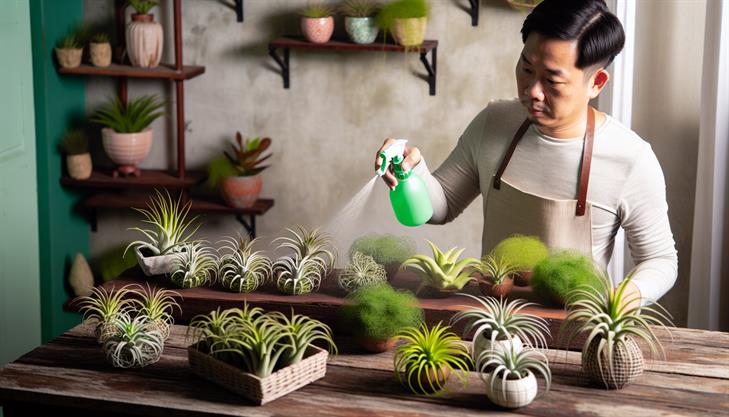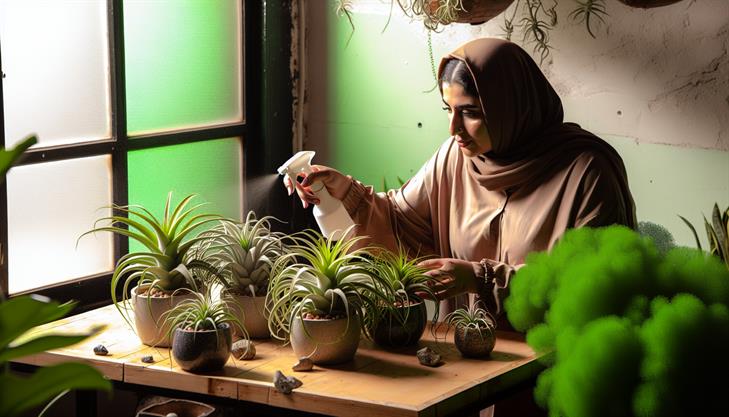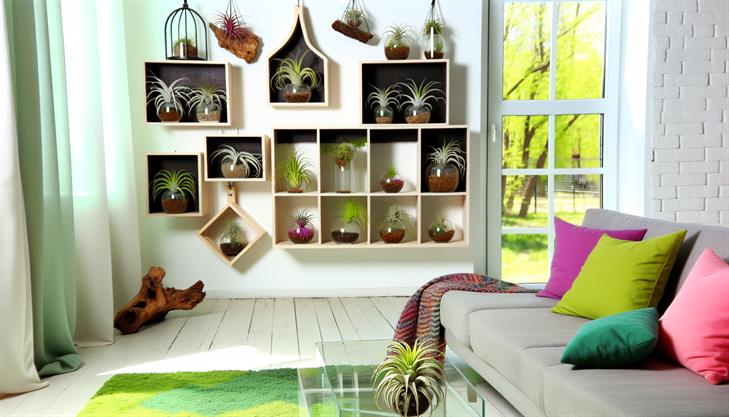In the vibrant world of indoor gardening, air plants have emerged as a captivating trend, defying conventional potting rules with their rootless, soil-free existence. These whimsical wonders, known for their resilience and unique aesthetic, are not just houseplants; they’re living art. Yet, despite their carefree appearance, air plants require specific care to truly thrive and display their magical allure. If you’re keen to unlock the secrets of maintaining these botanical delights, you’ve landed in the right place. This guide is your key to nurturing air plants into flourishing specimens that add a touch of nature’s intrigue to your space. Dive in to discover practical, expert-backed techniques that will transform your air plants from simple decor items into vibrant, living sculptures—because mastering their care goes beyond mere survival; it’s about appreciation and growth.
Understanding Air Plants: A Beginner’s Guide
Air plants, known scientifically as Tillandsia, are unique and fascinating plants that don’t require soil to grow. Proper care for air plants involves understanding their natural habitat and mimicking those conditions in your home. Here’s a comprehensive guide on how to take care of air plants:
1. Selecting the Right Environment:
Air plants thrive in bright, indirect light. Place them near a window where they receive plenty of natural sunlight, but avoid placing them in direct sun as it can dry them out. If natural light is scarce, consider using fluorescent lighting or grow lights.
2. Watering Your Air Plants:
Watering is crucial to keeping air plants healthy. Follow these steps:
-
Submerge and Soak:
Every one to two weeks, submerge your air plants in room temperature water for about 20 to 30 minutes. Ensure the entire plant is submerged for optimal hydration. If you live in a particularly dry climate or your home is heated, a more frequent watering schedule may be necessary. -
Shake and Dry:
After soaking, remove any excess water by gently shaking the plant. This is important because trapped water can cause the plant to rot. Place the plant upside down on a towel to dry fully before placing it back in its display spot.
3. Ensure Proper Air Circulation:
Air plants need good air circulation to prevent rot and promote healthy growth. If they’re enclosed in a terrarium or other display, ensure there’s adequate airflow, or take them out periodically to air out.
4. Feeding Your Air Plants:
Fertilize air plants once a month with a bromeliad fertilizer or a water-soluble fertilizer at 1/4 strength. Simply add the fertilizer to your soaking water to provide the necessary nutrients for growth.
5. Cleaning and Pruning:
Periodically remove any brown or dead leaves from your air plants to maintain their health and appearance. Trim back any dried or damaged tips with scissors, cutting at an angle to maintain a natural look.
6. Seasonal Adjustments:
During colder months, air plants may require less frequent watering. However, indoor heating can dry them out quicker, so monitor their needs closely and adjust your watering schedule accordingly.
Common Issues and Solutions:
-
Leaf Curling or Browning:
This usually indicates dehydration. Increase the frequency of watering and ensure that the plants are drying completely between waterings. -
Rotting:
Usually caused by too much water left in the base of the plant. Make sure you’re shaking off excess water and providing good air circulation. -
Pests and Mold:
Occasionally, air plants can develop mold if they remain wet for too long. In case of mold, rinse the plant thoroughly and ensure it dries correctly. Pests like aphids can be washed away with water and treated with non-toxic pesticides if necessary.
Display Advice:
Air plants can be creatively displayed in various setups including hanging or mounted arrangements, terrariums, or driftwood pieces. Ensure that the display allows for easy removal for watering and adequate airflow.
By following these steps and tips, you can successfully care for your air plants, keeping them vibrant and healthy. Whether they’re part of a larger green collection or standing alone as unique decor, understanding how to take care of air plants will allow you to enjoy these remarkable plants with minimal effort.
Essential Care Tips for Healthy Air Plants
Air plants, or Tillandsia, are unique and fascinating houseplants that derive nutrients through their leaves rather than their roots. Their low-maintenance nature makes them an attractive choice for plant enthusiasts. However, understanding how to take care of air plants is crucial for their health and longevity. Here is a comprehensive guide with essential care tips to ensure your air plants thrive.
Understanding Basics
Firstly, it’s important to recognize that air plants do not require soil and should be placed in a way that allows air to circulate around them freely. This fundamental difference affects all aspects of their care, from watering to displaying.
Watering Your Air Plants
Watering air plants is arguably the most critical aspect of their care:
-
Soak: Immerse your air plants in a bowl of room-temperature water for about 20 to 30 minutes once a week. If you live in a particularly dry climate, consider soaking twice a week.
-
Dry: After soaking, gently shake off excess water and place the plants upside down on a towel to dry completely. This prevents water from sitting in the crown, which can lead to rot.
-
Misting: In between soakings, mist your air plants with a spray bottle if they start to feel dry, particularly in more humid environments. However, misting should not replace soaking.
Light Requirements
Air plants appreciate bright, indirect sunlight. Direct sunlight can scorch the leaves, so place your plants near a window with filtered light or in a room that receives bright ambient lighting:
- Windowsills facing north or east are perfect as they offer gentle morning sunlight.
- Avoid prolonged exposure to direct midday sun which can cause damage.
Temperature and Air Circulation
Air plants prefer temperatures between 50°F to 90°F (10°C to 32°C), making most indoor environments suitable. Ensure there’s good air circulation, which can be enhanced by placing them near a fan or open window.
Fertilizing
Fertilize your air plants every month during their growing season (spring to fall) using a water-soluble orchid fertilizer:
- Dilute: Mix the fertilizer at half the recommended strength in water.
- Apply: Soak or spray your air plants in this solution to give them a nutritional boost.
Common Issues and Solutions
- Overwatering: Overwatering can lead to rot. Solution: Always dry air plants upside down to prevent water from pooling in the base.
- Underwatering: Brown tips can indicate dehydration. Solution: Increase soaking frequency and monitor closely.
- Lack of Light: Plants may become pale. Solution: Ensure they are exposed to adequate bright, indirect light.
Styling and Display Tips
Creative display options are one of the many appeals of air plants:
- Use decorative holders, glass terrariums, or driftwood to showcase your air plants.
- Remember, while aesthetics are essential, the health of the plant should always come first; ensure air and light access is not compromised by decorative choices.
Additional Advice
- Cleaning: Occasionally, gently rinse your plants to remove dust and pests.
- Grooming: Trim dead leaves using clean scissors to maintain their appearance and help the plant focus energy on new growth.
By following these care tips and understanding the specific needs of air plants, you can ensure they remain healthy and vibrant. Cultivating air plants can be a rewarding endeavor, adding beauty and a touch of nature to your living space without demanding extensive maintenance.
Watering and Feeding Techniques for Optimal Growth
Air plants, or Tillandsias, are unique and fascinating plants that don’t require soil for growth, making them an excellent choice for indoor gardeners looking for low-maintenance foliage. However, caring for air plants does require some specific attention to ensure they thrive. Below are comprehensive guidelines on how to take care of air plants, along with tips to address common issues.
Lighting
Proper lighting is crucial for the health of air plants. These plants thrive in bright, indirect light. Placing them near a window with filtered sunlight, such as behind a sheer curtain, is ideal. Direct sunlight can scorch their delicate leaves, while inadequate light will hinder their growth. If natural light isn’t sufficient, consider using fluorescent or LED grow lights for 12-14 hours daily.
Watering Techniques
Watering is often the most misunderstood aspect of how to care for air plants. Unlike traditional plants, air plants absorb moisture through their leaves. Here’s a step-by-step guide on watering:
-
Weekly Soaking: Submerge your air plants in room-temperature water for 20-30 minutes once a week. This mimics natural rainfalls they encounter in their native environments.
-
Shake Off Excess Water: After soaking, gently shake the plants to remove any excess water from their crevices, as stagnant water can lead to rot.
-
Drying: Place them in a well-ventilated area upside down on a towel until completely dry, which usually takes about 4 hours. Proper air circulation is crucial to prevent mold or fungus.
-
Misting: In addition to weekly soakings, mist your air plants 2-3 times a week, especially if your home is very dry.
Feeding for Growth
Feeding is important for optimal growth and blooming:
- Use a bromeliad or air plant fertilizer diluted to quarter strength.
- Apply fertilizer once a month during the growing seasons (spring and summer) by adding it to the soaking water.
- Avoid over-fertilizing, as this can burn the leaves and damage the plant.
Climate Conditions
Air plants prefer temperatures between 50°F and 90°F (10°C to 32°C) and do well in humid environments. If you live in a dry climate, consider enhancing the humidity by placing a humidity tray nearby or using a small humidifier.
Common Issues and Solutions
-
Brown Tips: Usually caused by underwatering or excessively dry air. Adjust your watering schedule and boost humidity.
-
Rot: This occurs from over-watering or poor air circulation. Ensure plants dry completely after watering, and reduce frequency if necessary.
-
Lack of Growth: May result from inadequate light or feeding. Increase light exposure gradually and ensure regular fertilization.
Additional Tips
-
Display: Use creative displays like wire mounts, shells, or driftwood, but avoid enclosures that restrict airflow.
-
Seasonal Care: Reduce watering in winter when growth slows but maintain regular misting to counteract indoor heating dryness.
Taking care of air plants involves adjusting to their unique needs but is ultimately rewarding as they add an exotic touch to any space with minimal fuss. By following these care instructions, your air plants are likely to flourish and provide beauty throughout the year.
Styling and Display Ideas to Enhance Your Space
Taking care of air plants, also known as Tillandsias, can be a rewarding addition to your home decor and styling ideas. These resilient plants do not require soil, making them versatile for creative displays. Follow these guidelines to ensure your air plants thrive and enhance your space beautifully.
1. Watering Air Plants Properly
Air plants absorb moisture through their leaves, as they don’t have a traditional root system. Ensure proper hydration by:
-
Soaking: Submerge your air plants in room-temperature water for about 20 to 30 minutes every one to two weeks. It’s best to use rainwater or distilled water, as tap water can contain chemicals like chlorine that are harmful to these plants.
-
Drying: After soaking, shake off excess water and place the plants upside down on a towel to dry for a few hours. Ensure they dry completely to prevent rot, particularly near the base.
-
Misting: In-between deep soaking sessions, mist your air plants lightly with water, especially in dryer climates or during warmer months.
2. Ensuring Adequate Lighting
Air plants thrive with plenty of indirect, bright light. Follow these steps to optimize their light exposure:
-
Placement: Position air plants near a window where they’ll receive filtered light. Avoid direct midday sun, as intense rays can scorch the leaves.
-
Artificial Light: If natural light is sparse, use fluorescent bulbs as a supplementary light source. Aim for around 12 hours of light exposure daily.
3. Temperature and Humidity
Air plants prefer environments with moderate temperatures and humidity:
-
Ideal Range: Maintain temperatures between 50-90°F (10-32°C). Avoid extreme temperature changes and drafts.
-
Humidity Level: Homes with higher humidity levels are preferable. In drier homes, increase humidity by occasionally misting the plants or placing them near a humidifier.
4. Fertilizing Air Plants
While air plants are low maintenance, occasional fertilization can boost their health:
- Frequency and Type: Use a water-soluble orchid or bromeliad fertilizer. Add this to your soaking routine once a month, following the package instructions for dilution ratios.
5. Common Issues and Solutions
Keep an eye out for these potential problems:
-
Rot: Caused by poor air circulation or leaving plants wet for too long. Ensure plants are completely dry after watering.
-
Browning Tips: Often a sign of underwatering or overexposure to direct sunlight. Adjust watering frequency and lighting conditions accordingly.
-
Pest Control: Though rare, inspect for pests like mealybugs. Rinse the plant with water and use diluted insecticidal soap if needed.
6. Creative Display Ideas
To maximize the aesthetic appeal of air plants in your space:
-
Use Glass Containers: Terrariums or glass bowls create a stylish display while offering some protection from temperature fluctuations.
-
Driftwood and Rocks: Affix air plants to driftwood, rocks, or shells using non-toxic glue or fishing wire for a rustic, natural look.
-
Hanging Displays: Suspend air plants with string or place them in macramé hangers to add a vertical element to your design.
By following these care guidelines, your air plants will not only thrive but also become a striking part of your interior design. Enjoy experimenting with different setups to suit your personal style and watch as your air plants bring life and tranquility to your space.
Troubleshooting Common Air Plant Problems
Taking care of air plants, also known as Tillandsias, is a rewarding hobby that is relatively low-maintenance compared to other houseplants. Here’s a step-by-step guide to ensure your air plants thrive, with extra tips on troubleshooting common problems.
1. Understanding Air Plant Basics
Air plants are unique because they don’t need soil to grow. They absorb moisture and nutrients through their leaves rather than roots, making them versatile for various display methods. Air plants thrive in conditions that mimic their natural environment: bright, indirect light, good air circulation, and regular watering.
2. Light Requirements
Place your air plants in a location where they can receive bright, indirect sunlight. Direct sunlight can be too intense, while insufficient light can stunt growth. If natural light is limited, consider using full-spectrum fluorescent lights. Position the plants about 6 to 12 inches from the source, ensuring they receive light for at least 12 hours daily.
3. Watering Your Air Plants
Watering is crucial in learning how to take care of air plants. Ideally, soak your air plants in room-temperature water for about 20 to 30 minutes once a week. For homes with drier air or during hotter months, consider misting them in between soakings. After soaking, shake off any excess water and ensure they dry completely within 4 hours to prevent rot. You can lay them on a towel or place them upside down on a rack.
4. Air Circulation
Good air circulation is vital for air plant health. Position them in open spaces, away from stagnant environments. This helps prevent mold and diseases, promoting proper drying after watering.
5. Fertilizing Your Air Plants
Fertilizing isn’t always necessary but can enhance growth and encourage blooming. Use a bromeliad or air plant-specific fertilizer diluted at half-strength every month during the growing season (spring and summer). Avoid over-fertilization, as it can damage your plants.
6. Common Problems and Solutions
- Browning Tips: Often a sign of dry air or insufficient watering. Increase humidity by misting more frequently or soaking a little longer.
- Rot: Usually caused by poor air circulation or water sitting in the plant base. Ensure plants dry thoroughly after watering and improve airflow around them.
- Pale Leaves: Typically indicates too much sunlight. Move to a spot with filtered light and avoid direct sun exposure.
- Drooping or Curling Leaves: Often the result of underwatering. Adjust your watering routine to meet the plant’s needs, considering environmental factors.
7. Display Tips
Air plants can be creatively displayed in terrariums, on driftwood, in shells, or hanging in glass globes. However, avoid closed containers without airflow. Remember, if using non-conventional holders like wood, make sure the material is untreated and won’t leach harmful substances.
Additional Advice
Regularly check for pests such as aphids or mealybugs. If detected, rinse your air plants under water and treat with insecticidal soap if needed. Additionally, periodically remove any dead leaves to maintain plant health and aesthetics.
By following these care instructions and being mindful of their environment, you can ensure your air plants remain healthy and vibrant, adding a touch of the exotic to your home or office space.
In conclusion, taking care of air plants can be a simple and rewarding journey with the right approach. By ensuring your air plants receive the appropriate amount of light and are soaked periodically rather than misted for hydration, you can promote vibrant growth and longevity. Remember to provide air circulation to prevent rot and choose the right environment, whether indoors or outdoors, to match their living needs. With minimal effort, air plants can thrive and add a unique, aesthetic touch to your space.
Now that you’ve learned the essentials, I encourage you to apply these techniques and see how your air plants flourish. Experiment with various creative displays around your home or office and enjoy the benefits of these versatile plants. As a final tip, once a month, consider soaking your air plants with a nutrient-rich soak by adding a fertilizer specifically formulated for epiphytes to your water. This can boost their vitality and encourage blooming, giving you even more to admire in your living decor.


